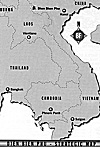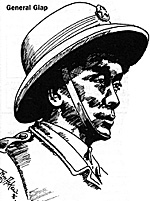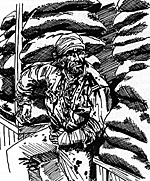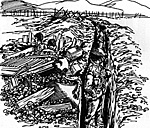LECLERC IN INDO-CHINA
When French general Leclerc, the liberator of Paris, arrived in Indo-China to restore French colonial power, he encountered a political situation that was chaotic. There were Japanese, British and Chinese garrisons. The Japanese had turned over power to the "emperor" Bao Dai, who had abdicated almost immediately and recognised the "government" of the Viet Minh, the communist "League for an independent Vietnam." At that time, the Viet Minh could count on some American support. Powerful religious sects and armed groups of ordinary bandits made the situation even more complicated. An agreement between the French and Viet Minh-leader Ho Chi Minh held for only a few months. In November 1946 clashes broke out. With tanks and veteran infantry, Leclerc soon took over the densely populated coastal strip. The Communists fled to the hills.
THE TIGER AND THE ELEPHANT
 But the war had just started. The APV (Armee Populaire Vietnamienne, Vietnamese People's Army) was led by Vo Nguyen Giap. Inspired by the successes of Mao against Tsjang Kai Tsjek in China, the Viet Minh started revolutionary guerilla-warfare. "It will be a war between an elephant and a tiger," Ho Chi Minh declared, "If the tiger stands, he will be trampled. But the tiger will always be on the move. He will tear apart the back of the elephant, before disappearing in the jungle. And in the end, the elephant will bleed to death."
But the war had just started. The APV (Armee Populaire Vietnamienne, Vietnamese People's Army) was led by Vo Nguyen Giap. Inspired by the successes of Mao against Tsjang Kai Tsjek in China, the Viet Minh started revolutionary guerilla-warfare. "It will be a war between an elephant and a tiger," Ho Chi Minh declared, "If the tiger stands, he will be trampled. But the tiger will always be on the move. He will tear apart the back of the elephant, before disappearing in the jungle. And in the end, the elephant will bleed to death."
A more prosaic Giap stated: "The enemy will be caught in a dilemma: He has to drag out the war in order to win it and does not possess, on the other hand, the psychological and political means to fight a long-drawn-out war..." Giap believed that the French parliament would not be prepared to vote astronomical credits forever without a clear-cut victory in sight and that public opinion in France would soon demand an end to the "useless bloodshed."
VIETNAMISING THE WAR
 When General Henri Navarre took command of the French forces in spring 1953, the war had dragged on for seven long years.
When General Henri Navarre took command of the French forces in spring 1953, the war had dragged on for seven long years.
The overall situation was far from good for the French. In France, the Communist Party and the socialists were now openly opposed to the war. The end of the Korean war meant that the Russians and Chinese only had one ally to support and that Ho Chi Minh got more supplies. The Viet Minh now controlled almost three quarters of the country. In the north, only Hanoi and its immediate surroundings were still in French hands.
This limited French military presence could only be secured by massive American support. To please the Americans, who aimed for an independent but non-communist Vietnam, the French had started to "Vietnamise" the war by the creation of an "associated" puppet-state led by Bao Dai and the creation of a Vietnamese National Army. But in fact, the French did not believe that the war could be won in the military sense. Navarre was to aim for a "coup nul," a draw, that would bring the Viet Minh to the negotiation table.
GENERAL NAVARRE AND HIS PLAN
In the autumn of 1953, it became clear that Giap was preparing an invasion of Laos, by then another "associated" state. Navarre decided to build "une base aero-terrestre"(a fortified camp with an air strip) in the valley of Dine Bien Phu in the highlands near the border with Laos, some 220 miles from Hanoi. The camp, in the middle of a valley that was 10 miles long and some 5 miles wide, was to be entirely supplied by air. It would allow the French to mount operations against the Viet Minh-supply lines. Air support would be available from aircraft based inside the camp. General Rene Cogny, Navarre's subordinate commander in the North, opposed the stand at Dien Bien Phu. NOnetheless, he was charged with overall planning and supply. During the battle, Cogny and Navarre would hardly be on speaking terms as they were trying to blame the other for the disaster.
OPERATION CASTOR
On 20th November, three battalions of French paratroops were dropped over Dien Bien Phu by 65 Dakota's. "Operation Castor" had started. Almost immediately, fighting broke out with a few hundred Viet Minh-regulars that were on training in the area. By dusk, the enemy had been cleared from the valley. On 22nd November, the French had already six battalions of paratroops on the ground, and 240 tons of material. The French engineers could start their work.
The central position with the 1150m long airstrip was to be protected by five groups of strongpoints: "Anne-Marie," "Claudine," "Huguette," "Dominique," and "Eliane." One mile to the north, there were two other strongpoints on the hills dominating the position: "Gabrielle" (491 metres) and "Beatrice" (509 metres). Four miles to the south, "Isabelle" covered a second airstrip. It was said that the strongpoints were named after the mistresses of the commander of the camp, the dashing and womanising colonel Christian de la Croix de Castries. Part of the paratroops were now replaced by ten air-lifted infantry battalions: four Foreign Legion, three Algerian, one Moroccan and two T'ai-montagnard. The camp received 28 guns, 10 M24 "Chaffee" tanks and 11 Bearcat fighter-bombers. The total garrison was now more than 10,000 men, but part of these were not combat infantry. Unfortunately, the garrison proved too small to hold all the hills in the valley, so that some hills overlooking the camp were left to the Viet Minh.
FRENCH OPTIMISM
 Despite this build-up of forces, it soon became apparent that offensive operations were impossible, due to the heavy resistance the French met each time they left the camp. By early January, Dien Bien Phu was completely surrounded. From the beginning of February, the airstrip occasionally came under fire. But French optimism was not tempered. They now decided to wait for Giap's attack against the camp. Then, with the enemy finally in the open, the artillery and air force would surely smash the Viet Minh. Navarre thought it would be impossible for the Vietnamese to move a significant number of guns and the necessary ammunition through the jungle to significantly threaten the strongpoints and if they did the Vietnamese guns would soon be silenced by the French fighter-bombers and artillery.
Despite this build-up of forces, it soon became apparent that offensive operations were impossible, due to the heavy resistance the French met each time they left the camp. By early January, Dien Bien Phu was completely surrounded. From the beginning of February, the airstrip occasionally came under fire. But French optimism was not tempered. They now decided to wait for Giap's attack against the camp. Then, with the enemy finally in the open, the artillery and air force would surely smash the Viet Minh. Navarre thought it would be impossible for the Vietnamese to move a significant number of guns and the necessary ammunition through the jungle to significantly threaten the strongpoints and if they did the Vietnamese guns would soon be silenced by the French fighter-bombers and artillery.
But Navarre chronically underestimated his enemy. Giap had requisitioned 75,000 coolies. They built a 200 miles long road through the thick jungle towards Dien Bien Phu. The French air force could hinder them only occasionally, as the pilots had great difficulties finding their targets hidden in the jungle. When the road was finished, some 800 Soviet Molotova trucks (2.5T) and 20,000 bicycles each carrying 200 kg. of supplies, stood ready to support the 49,500 men (of which 35,000 were combat infantry) and the guns that Giap had positioned around Dien Bien Phu. The Viet Minh also had a number of heavy mortars and, maybe most importantly, Chinese-trained anti-aircraft units.
THE FALL OF GABRIELLE AND BEATRICE (13-16TH MARCH)
It was in fact the French that had a supply problem, According to the plans, the French needed 30,000 tons of material to build the camp. Fully occupied, the Armee de l'Air (Air Force) could only deliver 150 tons per day. Thus, the French needed 200 days. But the Vietnamese were ready first and attacked before the French defences were completed. On 13th March 1954, at 17:10, a massive and accurate artillery barrage fell on the camp, opening the battle proper. As usual, the Viet Minh attacked just before dark, when their gunners had enough light to see their targets, but when there was not enough time left for the French air force to intervene.
From the start, all went wrong for the French. Following the advice of his Chinese friends, Giap had dispersed his guns all over the valley, so that the French had to locate each piece separately. The fighter-bombers could hardly find the Viet Minh-artillery in the brilliantly camouflaged casemates, let alone destroy it. Soon, the airstrip was blocked by burning wrecks, making it difficult for the Bearcats to take off. The French artillery proved very vulnerable and took heavy losses (the French had neglected to protect their guns gains counter battery fire so sure were they of establishing immediate fire superiority). Viet Minh "volunteers of death" made breaches in the barbed wire with bengalore-torpedos or even by throwing themselves forward, their bodies loaded with explosive charges. Trenches and bunkers (made of wood and sand, not concrete) collapsed under the hail-storm of shells.
On the first night, only a few hours after the battle had started, "Gabrielle" was lost. The elite 3/13 DBLE (Foreign Legion) defending it, was swept away by six Viet Minh-battalions. The unit had lost 325 killed and most of the survivors were wounded. The next day, the 5 BPVN was parachuted in to replace it. In the evening, "Beatrice" was attacked. This excellent position, stoutly defended by the Algerians of the 5/7 RTA, came under heavy pressure from eight enemy battalions.
In the early morning of the 15th March, a counter-attack by 7 tanks, the 5 BPVN and some Foreign Legion-para's, succeeded in relieving the 150 surviving Algerians, but in the end the French pulled back and Beatrice was lost. The Vietnamese had paid a heavy toll for these victories: they had lost 3,000 men. On the French side, one fifth of the infantry and one third of the guns were out of action. More than a quarter of the ammunition was already spent. Colonel Piroth, commander of the French artillery, took the blame for the disaster on himself and committed suicide.
LANGLAIS TAKES OVER
"Gabrielle" and Beatrice" had been vital for the defence of the camp. From these captured positions, the Viet Minh anti-aircraft guns made use of the airstrip almost impossible. After 28th March, supplies were no longer flown in, but dropped at night into a shrinking perimeter. Of course, a significant part of the supplies fell in the hands of the Viet Minh. As the Viet Minh used the same 105mm guns as the French (supplied by China these were American pieces captured in the Korean War), the artillery ammunition captured by the Viet Minh was not only lost, but also used against the French. Things got worse by the day. On 16th March, the crack 6th Colonial Para Battalion was parachuted in. But on the other hand a whole battalion of ethnic T'ai-highlanders (BT3) deserted, while the other T'ai (BT2) had to be considered as unreliable.
With the loss of BT3, most of Anne-Marie was given up. All the fighter-bombers being destroyed on the ground, the pilots were helicoptered out. On 21st and 22nd March, the French succeeded in re-opening the road between the main camp and Isabelle, that had been cut off. But this small success could not restore the confidence in colonel de Castries, the commander of the camp. In the morning of 24th March, the commanders of the paratroop-battalions informed de Castries that they would no longer obey his orders. De Castries was so shocked by what had happed and by the fate of the officers of his staff (Keller: nervous breakdown, Gaucher: killed, Piroth: suicide) that he accepted being only the nominal commander and that paratroop Lt. Col. Pierre Langlais would take all the tactical decisions.
THE BATTLE OF THE FIVE HILLS (30TH MARCH-6TH APRIL)
 On 29th March, a persistent rain started an soon the valley was more often than not covered with mist. Air strikes and supply drops became even more uncertain. The poorly constructed trenches melted away in a sea of mud. But the fighting went on. From 25th March, the Vietnamese launched probing attacks against the French positions on "the five hills" (Dominique and Eliane) on the east side of the camp. On 30th March at 18:00, the Viet Minh opened a devastating fire on the five battalions defending these positions. Then, out of trenches no further away than 150 yards, waves of Viet Minh infantry appeared. The Algerian and T'ai defenders of Dominique fled, leaving a battery of four guns manned by Senegalese as the only obstacle between the Viet Minh and the heart of the French camp. Instead of retreating their pieces as ordered, the Senegalese artillerists just kept on firing in the dense masses of Viet Minh infantry and succeeded in stopping the attackers. Giap was so furious that he ordered the execution of the officer responsible for the failure of this attack.
On 29th March, a persistent rain started an soon the valley was more often than not covered with mist. Air strikes and supply drops became even more uncertain. The poorly constructed trenches melted away in a sea of mud. But the fighting went on. From 25th March, the Vietnamese launched probing attacks against the French positions on "the five hills" (Dominique and Eliane) on the east side of the camp. On 30th March at 18:00, the Viet Minh opened a devastating fire on the five battalions defending these positions. Then, out of trenches no further away than 150 yards, waves of Viet Minh infantry appeared. The Algerian and T'ai defenders of Dominique fled, leaving a battery of four guns manned by Senegalese as the only obstacle between the Viet Minh and the heart of the French camp. Instead of retreating their pieces as ordered, the Senegalese artillerists just kept on firing in the dense masses of Viet Minh infantry and succeeded in stopping the attackers. Giap was so furious that he ordered the execution of the officer responsible for the failure of this attack.
By now, all eyes were fixed on Eliane, defended mainly by Moroccans and the 5 BPVN. "This was no longer war. This was hell, this was Verdun," a French officer later remembered. The French positions, little more than holes in the mud, wee lost and retaken only to be lost again. Enemy sappers were infiltrating the French positions and strangling one strongpoint after another. Some Viet Minh elements even succeeded in occupying the trenches near the airstrip. Isolated points of resistance were swept away by human wave assaults. But some French held their positions and a counter-attack of two battalions of paratroopers reconquered Dominque and some earlier lost high ground on Eliane. Sadly, a sheer lack of manpower to hold the positions forced the French to give up most of the reconquered ground. The French were exhausted and short of everything. But they held. By 4th April, the Viet Minh attacks faded away. To find the manpower to hold the east side of the camp, Langlais had ordered the evacuation of some positions on the west side (Francoise and part of Huguette). The rest of Huguette, defended by a handful of paratroopers, Foreign Legion and some tanks commanded by a sergeant called Ney, came under heavy pressure but held out. Langlais was now left with little more than 2600 reliable combat infantry. Odds had dropped from 4:1 at the start of the battle to 10:1.
THE RATS OF NAM YUM
Conditions for the wounded were desperate. Although there were 19 French doctors, the French had planned to evacuate the wounded by plane, so the hospital in the camp only had 44 beds. But by mid-April, there were more than a thousand wounded. The Viet Minh had to do with only 7 doctors, of which only one was a surgeon. Both sides were desperately short on narcotics, medicine and even bandages. Giap refused any understanding regarding the wounded, even the most serious cases. He even refused to take back his own wounded, thus -- as Marxist revolutionary warfare prescribed -- maximising the pressure on French morale. Many of the French troops deserted or gave up the fight. Not all of them went over to the enemy. The majority hid on the banks of the Nam Yum rivers, begging for food or stealing it. Curiously, both de Castries and Langlais tolerated these "rats of Nam Yum," who would number no less than 4,000 by the end of the battle. Apart from these "rats," there were some 2,000 Viet Minh prisoners to be fed each day.
To Dien Bien Phu (Part 1: section 2)
To Dien Bien Phu (Part 2 in Volume 1 Issue 5)
Back to Battlefields Vol. 1 Issue 4 Table of Contents
© Copyright 1996 by Partizan Press.
This article appears in MagWeb (Magazine Web) on the Internet World Wide Web.
Other military history articles and gaming articles are available at http://www.magweb.com